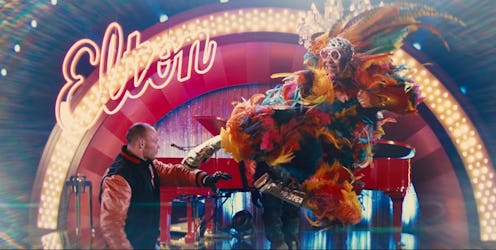Entertainment
How Hollywood Is Still Majorly Failing LGBTQ Audiences, According To A New Study
New statistics released by GLAAD will likely leave you more than a little disheartened. In their recent report, GLAAD revealed that Hollywood exhibited a sharp decline in LGBTQ representation in movies in 2017. While major studios have historically done poorly with representing characters from marginalized demographics, the new results from GLAAD's 2018 Studio Responsibility Index prove that the issue isn't getting better. In fact, the problem is getting worse, as only 12.8 percent of the 109 movies released from major studios in 2017 included characters that are LGBTQ. During the year before, GLAAD found that 18.4 percent of major studios' releases included LGBTQ characters, and the recent decline is even more discouraging when you look even more closely at the data.
Along with their general results, which showed a shockingly low proportion of LGBTQ representation, GLAAD's SRI also found that none of the 109 major releases from 2017 included transgender characters, nor did they feature Asian/Pacific Islander LGBTQ characters. That means that Hollywood's major studios aren't only lacking in terms of including LGBTQ characters, but they're also failing at featuring a wide range of demographics within their already low LGBTQ representation.
While the complete lack of Asian/Pacific Islander LGBTQ individuals in films from 2017 is shocking, that doesn't mean there weren't actors of color playing LGBTQ characters in 2017. In fact, GLAAD found that 57 percent of LGBTQ characters in their study were played by people of color. While 57 percent sounds like a significant figure, it actually still doesn't mean much when you consider that the 109 major studio releases only included 28 LGBTQ characters in total, according to per GLAAD. That means that of those 28 characters, 16 of them were played by people of color, and even that measly number failed to include Asian/Pacific Islander LGBTQ characters. If you thought that Hollywood's representation problem was improving, these statistics probably make you want to rethink that.
If you're wondering why the latest GLAAD SRI turned out so poorly while the big-time Oscar-hits like Call Me By Your Name centered around a gay couple, and other popular movies like Lady Bird from 2017 included LGBTQ characters, you have to look at GLAAD's methodology for conducting its SRI. It's true that Call Me by Your Name — directed by Luca Guadagnino, who is gay — successfully told the story of gay romance that seemingly swept the nation, but that film wasn't released as widely as anyone living in an urban area might expect.
Sony Pictures Classics, the independent arm of Sony Pictures Entertainment, only released Call Me by Your Name in 914 theaters. Compare that to Sony Pictures Entertainment's movies like Spider-Man: Homecoming, which had a release in 4,348 theaters, and you can see why GLAAD only includes major studio films in in their study, which includes films released by 20th Century Fox, Universal Pictures, Paramount Pictures, Sony Entertainment, Walt Disney, Lionsgate Entertainment, and Warner Brothers.
GLAAD also uses specific criterion when considering LGBTQ characters' representation when appraising which major film studios pass and which fail — because yes, the SRI actually gives the studios ratings. That system is similar to the Bechdel test, but while appraising a film's representation of LGBTQ characters, GLAAD uses what they call the Vito Russo Test. Simply including an LGBTQ character in a movie doesn't necessarily promise that a film will pass the Vito Russo Test — that's just the first requirement. According to GLAAD, the other requirements are that the LGBTQ character cannot only be defined by their sexuality (i.e., they must have other defining qualities), and also that they must have an important enough role in the film that their removal in it would affect the plot.
The Vito Russo test should be easy enough to pass, but GLAAD's results reveal that it's not as simple as you might think. For example, in the 20th Century Fox film Snatched, starring Amy Schumer and Goldie Hawn, the characters Barb and Ruth (Joan Cusack and Wanda Sykes, respectively) go on vacation together and at first come off as a couple. GLAAD's SRI report explains the film's failing score by saying, "The film’s implication is that [Barb and Ruth] are a committed couple, up until [a] 'platonic best friend' line. We wish Snatched would have just gone all the way and let them be a couple."
In another movie, however, a short cameo that you might not expect to have made a difference allowed the movie to pass the Vito Russo test. That movie was Kingsman: The Golden Circle, which featured a short cameo by Elton John. As GLAAD's report explains,
"Though at first it seems to be just a fun celebrity cameo, Elton is actually instrumental [to the film's plot]. Of all the celebrities the film could have used in this stunt casting, it was a nice touch that their choice was one of the most iconic gay figures of this era. However, if this franchise continues, it would be nice to see queer characters in more than just cameo roles."
With 2018 well underway, it's hard not to look at the movies that have come out recently that might fail the Vito Russo Test with just one line like the one in Snatched. GLAAD's in-depth report certainly serves as a reminder that LGBTQ representation isn't as simple as including a gay character who only appears to serve as comic relief. Meaningful representation includes people of all colors playing the roles of LGBTQ characters, and including everyone, in important roles in major studio films.
